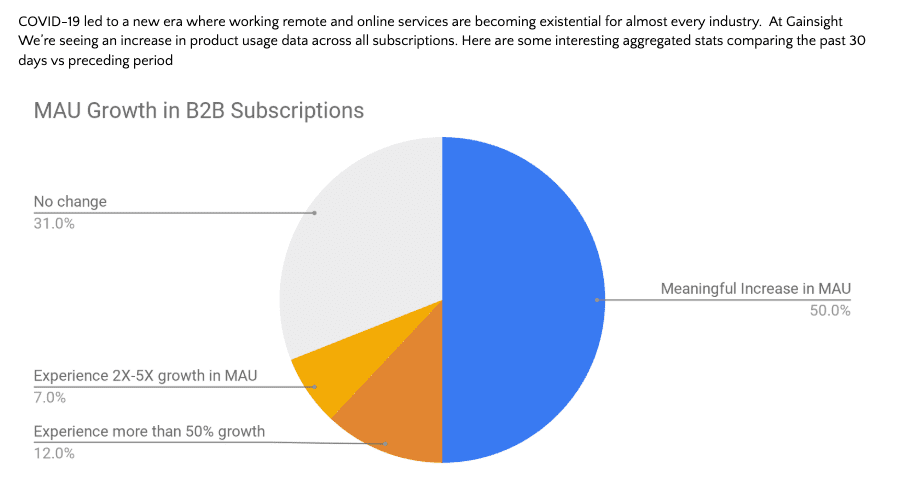5 Ways to calibrate your product & GTM strategy with Product-led growth
It feels like someone pulled the plug on the world’s economy and we’re on the verge of a downturn. As humans, during times of uncertainty, our mindset is quickly changing towards short-term goals and sustainability. The market instantly becomes volatile and companies are focusing on the fundamental business metrics.
The new normal
Global disruptions force humans and businesses into an evolution cycle and into a new reality to which we have to adapt. Some companies will require pivoting and transform overnight, some will require business reprioritization and for some, it’s an opportunity to invest and be ahead of the curve as we realize the “new normal”.
Globalization and digital transformation
The GTM models will change forever in this new normal. Businesses will have to rely on global resources, digital customer communication, and leverage different sources of supply. Local businesses will shift towards globalization, where design, production, and delivery are distributed. It means digital transformation and digital experience is an essential part of the new normal.
The demand for subscription services is on the rise
At Gainsight PX we were able to measure usage across subscriptions and noticed a significant uptick in usage.

|
COVID-19 led to a new era where working remote and online services are becoming existential for almost every industry. At Gainsight PX – we’re seeing an increase in product usage data across all subscriptions. Here are some interesting stats comparing the past 30 days vs the preceding period:
- 50% of the customers experienced an increase in their DAU(daily active users)
- 12% experienced more than 50% growth in the past 30 days compared with previous months
- 7% experienced more than 2X DAU (few are now on 3X-5X)
A new era for customer experience
In B2B the GTM model is based on high-touch, where sales cycles are longer and vendors tend to rely on hand-holding the customers throughout the different stages from prospecting to onboarding, renewal, and expansion. This model might become a blocker for growth at a certain stage and a change needs to happen in order to propel the business to sustainable growth.
In today’s reality, regardless of how deep or feature-rich your product is, customers expect fast time to value & ease-of-use while having the flexibility to apply more advanced product capabilities over time. The outcome of that expectation translates to smaller upfront customer commitment (land / low cost) and only increasing the contract value (expand) when success is realized.
Shifting towards sustainability
Software-based products (SaaS) are required to calibrate their GTM and product strategy to a more scalable and sustainable model by optimizing the fundamental B2B SaaS metrics which are coupled with the cost of doing business: Customer acquisition cost (CAC), Cost of retention and Customer lifetime value (CLTV).
| Customer Acquisition Cost = Sales + Marketing + Onboarding / # of New Customers
Cost of Retention = (CS + Tech + O + AM + CM) / AC *CLTV = Customer value X Average customer lifespan *Multiply customer value by the average customer lifespan. This will give you the revenue you can reasonably expect an average customer to generate for your company over the course of their relationship with your business. |
These metrics are leading indicators for measuring business models. The effectiveness and efficiency of sales, marketing and success heavily impact the overall business performance of the company and there are several ways to scale and yield better results by optimizing the GTM motion as well as calibrating your product strategy.
5 Ways to calibrate your product & GTM strategy
- Take a customer-centric approach – Customer experience becomes the key priority regardless of the organization’s guiding principles, culture, size, or budget. Avoid discrete hands-offs between marketing, sales, product and service organizations that don’t map well to how people want to try, buy, and use software today.
- Optimize customer acquisition cost (CAC) by calibrating marketing & sales funnels with product-led approach. Offer free trials and specialized up-sell packages. Focus marketing to drive online awareness campaigns to accelerate sign-ups.
- Reduce cost of retention with tech touch by introducing a scalable and more sustainable user onboarding, build personalized adoption journeys using automation. Enable customers to be self-sufficient with contextual in-app messaging and supporting content.
- Increase CLTV by prioritizing product roadmap for product adoption with a higher focus on accelerating time-to-value and usability which helps businesses achieve more with less. Balance product investments between delivering better experience at scale and new functionality. Use product experience data to identify challenges and opportunities that address changing customer needs.
- Reduce friction by aligning your product offering and GTM with a land & expand motion, differentiate by usage level as a gateway to value-added features that can purchase based on growing needs and product expansion strategy.
Conclusion
While this is an unprecedented time for most parts of the world, it is also a highly visible time for your product. Gainsight PX can help you understand your user analytics as they vary during this disruption and help with best in class onboarding to reduce retention costs. Join us for a demo to see how we can help you today.


